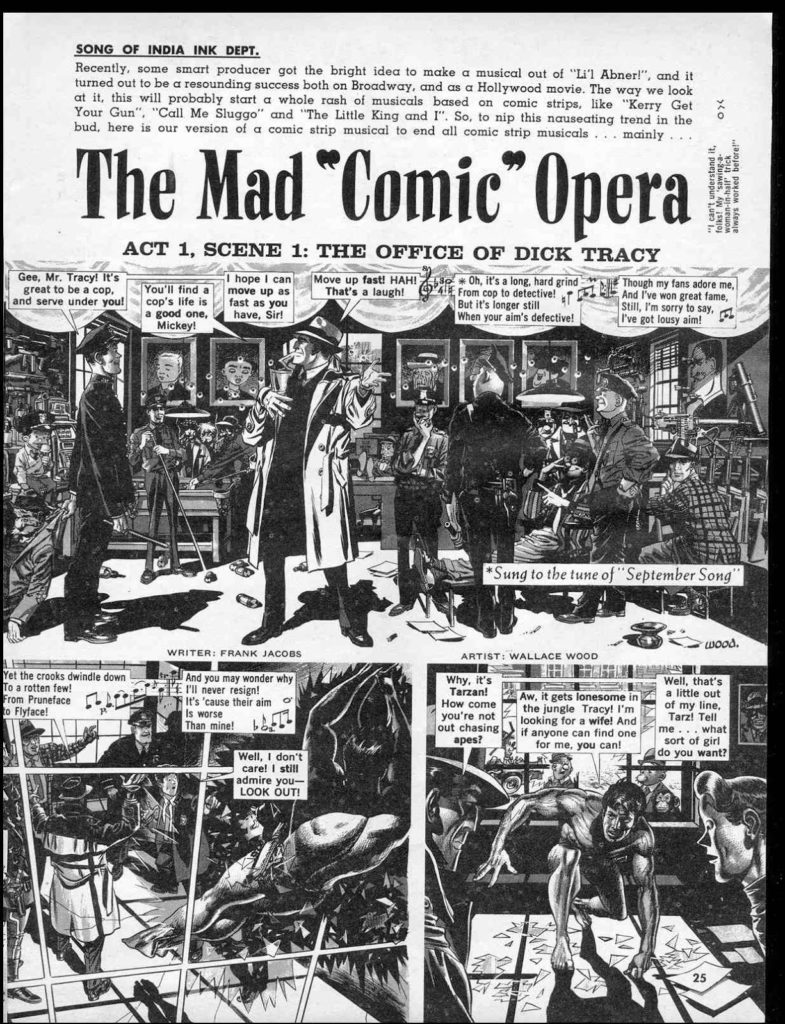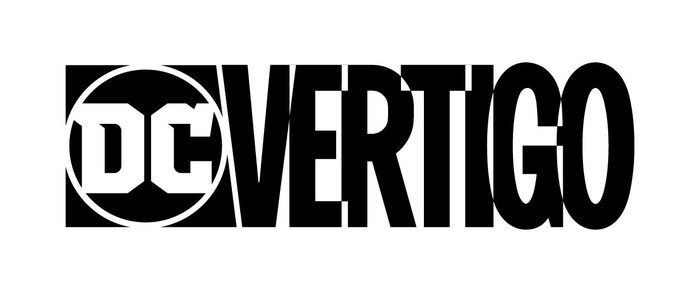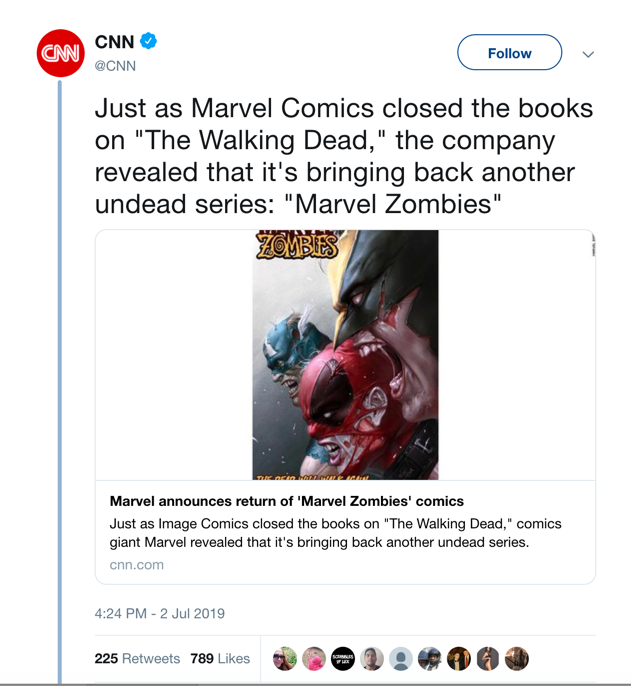0:01-3:42: Greetings from Graeme “Recorded Saturday But Thought It Was Sunday” McMillan and Jeff “Edited Sunday But Thought It Was Monday” Lester! On this long holiday weekend, we are recovering from a busy week, mainly by listing all the things we are not doing to relax. Does that sound like we have a problem? It kind of does, doesn’t it?
3:42-14:31: While we’ve either been off-air or Drokking, things have been happening in the world of comics news. In fact, we are at the end of no less than two eras! And we start off by talking about the first one: the announcement that Mad Magazine will cease publishing new material. We talk about the amount of upset online despite not paying much attention to it online, the change in American humor, and much more.
14:31-1:06:28: Mad Magazine comes after the news that Vertigo is being shuttered (along with new imprints Zoom and Ink) and…did we even talk about that? We honestly can’t remember! So we tackle it (again, for the very first time?), and talk about what’s happening to the books scheduled to come out under Zoom and Ink, the Hill House imprint, their announcement of creator-owned titles, how the rollout could’ve been handled differently, why DC Black Label is going away as an imprint but staying on as an age group, Batman as brand, DC as a “distracted, nonsensical publisher,” DC before Vertigo, the current publication status of Second Coming and Safe Sex; AND MUCH MORE.
1:06:28-2:12:39: The other end of an era news? The Walking Dead has ended as a comic book. Abruptly. As in the most recent issue (#193) is the final issue, the issues already solicited to be published after that were apparently fakes, and Robert Kirkman and Charlie Adlard’s latest issue is now also the last. That is a surprising end to the largest independent comic of our era (and arguably any era, depending on how you want to quantify the success of things like TMNT) and we talk about how it ended, why it ended, and what it means for Image now that their three biggest comics (TWD, Saga, and WicDiv) are now, essentially, over. Although we try at first, this conversation is definitely a full-SPOILERS discussion of the final storyline and the final issue. Discussed: the final story arc for TWD; why sales collapsed for the series; how Jeff, long-term reader of TWD, feels now that it’s over; what caused the zombie apocalypse and the Star Trek finale feel to the end of the series; the last Image book that sells over 20k in the North American market; the new announcement from Image that came out ahead of SDCC; Kirkman’s other publishing strategies through Skybound; and speaking of SDCC, are DC and Image going into SDCC and being perceived as being in trouble; comic book marketing as compared to the marketing of other entertainment media; and a lot more.
2:12:39-2:24:40: We are more or less aware that somehow the entire episode has flown by, Drokk!! Ep. 6 is next week, and we both think there’s something we’re forgetting to talk about? Jeff suggests people go to Deb Aoki’s twitter which is normally filled with all kinds of goodness but is extra-full-to-bursting recently with Anime Expo news, such as the first episode of Vinland Saga appearing on Prime Video on July 8; the release of the Project Anime whitepaper about the status of manga in North America; and many, many other tidbits.
2:24:40-end: Closing comments! Look for us on Stitcher! Itunes! Instagram! Twitter together and separately: Graeme and Jeff! Matt! Tumblr, and on Patreon where a wonderful group of people make this all possible, including Empress Audrey, Queen of the Galaxy, to whom we are especially grateful for her continuing support of this podcast. (Also, don’t forget about Spotify!)
Next week: Drokk!! Next week!!






For all your cutting and pasting needs, try:
http://theworkingdraft.com/media/podcasts3/WaitWhat274.mp3
The discussion of how DC is different from Marvel reminds me of something I’ve heard a lot from people running youtubes these days: the website rewards people who post the same kind of thing on the same kind of schedule. I wonder if thats just how things are these days.
Graeme, about publishing and identities: MacMillan has been staggeringly successful with Tor.com – the crew there has brilliantly folded in effective PR with publishing a large fraction of the shorter-than-novel-length award winners in sf and fantasy and just a ton of interesting stuff from well-moderated re-reads/re-viewings to James Nicoll on feminist sf writers of the 1970s and whatever.
It is, of course, pretty unique.
The thing that may have impacted the Walking Dead’s collapse was fatigue from the show landing on the book. I don’t follow either, but the response from the last episode of the last season, with Rick spinning off into movies, did not seem to land well with anyone. I don’t know how how closely the timelines match up, but it could easily be that the show’s decline wore out reader’s goodwill for the books as well, to the point where everyone abandoned the book at the same time. Again, I don’t pay much attention to the franchise at all, so this could be entirely off base.
Just chiming in to say that I think Graeme McMillan is completely right about Mad Magazine, but doesn’t go far enough.
Even when I was a child, I could detect that Mad was already dated, that this was something that was past its heyday, that it was performing over and over again a kind of humor that was part of the attitudes of a bygone time. Obviously, when I was a child, that time was a lot closer than it is today, but that maybe just made the fact more obvious that Mad was performing over and over again something that had once been genuinely subversive, but now was just a simulacrum of being subversive — that the world that Mad was trying to subvert was not there to subvert any more.
Basically, what I’m saying is that Mad should have been taken out back and shot in the head sometime around the election of Ronald Reagan. This isn’t because I don’t respect it — it’s because I think that there’s nothing more antithetical to what I understand it once stood for than to suffer the fate of becoming a “cultural institution.”
I think the collapse in monthly sales for THE WALKING DEAD was disguised by the variant covers. Kirkman didn’t do them, except for a few special issues, until #151, when Art Adams did a six issue connecting run of variants, which really bumped up sales. More recently there was the year of portrait variants by Bill Sienkiewicz. Once those stopped, for the final arc (by which time Kirkman probably decided to at least kill Rick, if not end the book), that’s when sales fell below 50k for the first time since before #100.
I wonder if Kirkman will try to do a colour reprint series for the book (I know he did the first issue, but beyond that)? It’s been done with lots of successful b&w comics (Bone, RASL, Scott Pilgrim, TMNT, Elfquest, From Hell, The Babysitters’ Club, Age of Bronze, upcoming for Usagi Yojimbo), and would seem to be a way to keep the property alive for a few more years.
Do Variant Cover make that much of a difference in goosing sales? I don’t collect variants so I am surprised they have that much impact on how well a book does. I like seeing all the variants in a collection but I never seek them out.
Reading various sales charts over the years suggest to me that yes, variants do reliably boost sales. But it may be rather like taking drugs: you get that short-term hit that improves your performance, at the cost of damaging your long-term health.
I think you’re mainly a reader and not mainly a collector? (So am I.) Variant covers prey on and exploit the collector, who wants to have a complete collection. Even more nastily, they exploit retailers, who has to order more of a title than they otherwise would to get the variants.
Like a drug addict, the publishers use variant covers as an easy way to get that hit, to extract more money from their existing customers, without having to do the hard work of finding a way to build their audience. I doubt that a single new person starts buying comics* because they thought, ”Wow, there are all these variant covers”
*Since the collector bubble collapsed, that is. Obviously, there were people in the early ‘90s who thought they would be retiring to Florida on variant covers. But I assume that the current collector market is better-informed, and composed of people who just want to have a complete collection for its own sake.
Thanks for the education on variants and Bob H for the #’s on The Walking Dead. I am just a reader. I was a collector at one point but now basically an accumulator. Read and then stack and rack them. I guess the variants are the equivalent of the lenticular covers, multiple colors, holograms etc. of the 90’s. Just amazed they artificially jump the sales so significantly, even for the short term.
Well, we only have the Comichron sales estimates to judge, which don’t break down by cover, but the first TWD with an Art Adams variant (#157, not #151 as I misremembered) sold almost 30k more than the book had been averaging (more with re-orders) and while sales drifted down the run continued to sell higher than it did with one cover. The first Sienkiewicz variant sold over 22k over the previous single cover issue, and the single cover issue after a year of Sienkiewicz variants dropped almost 12k and then kept falling until the surprise death of Rick..
One weirdo’s opinion: MAD has been weak sauce for a very very long time. The only time MAD elicited some kind of response from me was when I was a budding weirdo in middle school (early 1970s) when I read the Signet paperback reprints from the early 1960s (when I was a tot). I specifically liked MAD IN ORBIT and SELF-MADE MAD (containing the brilliant comic strip opera by Wood – Dagwood’s death scene is stellar!) because they made me feel slightly queazy (in a good but queazy way). One of the few I bought off the stands was #200 with the CLOSE ENCOUNTERS cover and parody. I was 19 and already had been watching, The Addams Family, Laugh-In, All in the Family, Young Frankenstein, early funny Woody Allen films, Monty Python, Early SNL, Dr. Demento and a weekly radio show featuring comedy record cuts all of which had some edge. In comics, I already had years of Peanuts, Tumbleweeds, B.C, Wizard of Id (which were all good up to then), and weird old Brenda Star: Reporter (which was incredibly weird in the 70s) under my belt and already had started to (finally) get my hands on *Crumb!* and other undergrounds from college based head shops. B.Kliben and Edward Gorey paperbacks were in the newly built mall bookstores as was the first year of Heavy Metal (weird AND tits). I even had gotten some early Cerebus. I was also listening to Punk music. MAD was dull as dishwater (IMO) compared to all of them despite having top artists and writers – many of which had been there a long time and would continue to be there for years if not decades. The ideal age of a MAD reader was probably middle school age when you start to try to figure out what the adult world is about so I was already too old. By the late 70s weird funny shit could be easily found if you were looking. That was 40 years ago and it’s expanded exponentially from that.
I have a cartoonist friend who has been a regular MAD contributor for the last several years (it was a lifelong dream of his) and he always encouraged me to contribute some stuff but I could never work up the enthusiasm to get something together. MAD had been essentially a “closed shop” in terms of using new contributors for most of my career. I was a regular contributor to Al Goldstein’s SCREW (a porn-y MAD parody for idiots) for most of the 90s into the early 00s (when it folded) where I could essentially do what I wanted (as long as it had something for the prurient interested) thanks to a generally laissez faire editorial policy. MAD editorial would have been murder. MAD would have paid more but I liked the freedom.
Recently, I had been checking out MAD to possibly contribute to again but was
REALLY underwhelmed. Most of the cartoonists, although excellent, had done better work elsewhere. My friend had had a lot of editorial changes to his original ideas often to soften them. When I picked up the new MAD #1 expecting some kind of change, it bore no outward change at all from the previous issue. It was the same damn thing. I thought I’d read somewhere where Michael Deforge was contributing but I never saw it – he would seem like a good fit (but why should he when he could do what he wanted without interference elsewhere). It seems like it’s been aimed at nostalgists over 50 done by guys who’s average age must be 65 (hardly any women contributors – still) as old as the magazine itself. Any yes, even though those are my peers, I’d prefer younger and more diverse voices (as well as seasoned vets with sharp satire teath) – but then – it probably wouldn’t be MAD anymore. MAD had (probably) 20 good/great years and 50 ok/meh ones. RIP.
Congratulations on 10 years hundreds and hundreds of hours of great conversation, guys! I hardly read (or see) anything you guys talk about but your talk is incredibly interesting and insightful on its own. Cheers!